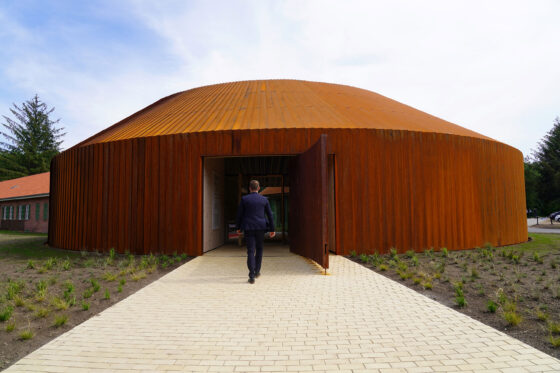
Built on the site of a former German World War II refugee camp, a new museum dedicated to exiles in Denmark will open on Wednesday to better tell the personal stories behind forced migration.
Christened “Flugt” – the flight, in Danish – it has just been inaugurated in Oksbøl, a small town on the western coast of the Scandinavian country, one of the states in Europe with the most difficult border in terms of immigration. In what was once the camp hospital, to which a modern wing has been added, surrounded by personal belongings – from a tent to a teddy bear – the exhibition follows the individual journeys of the exiles.
The story, at the origin of the place, of the German refugees at the fall of Nazism, but also of those who have found refuge in Denmark to flee war and oppression. “We want to tell the story, behind the numbers, of real people”museum director Claus Kjeld Jensen told AFP.
Here, in the twilight of the 1939-1945 war, tens of thousands of Germans fleeing the advancing Red Army found refuge on these military grounds of North Sea moors and beaches. Oksbøl had then become the fifth largest city in Denmark in terms of population in just a few weeks.
In the camp, operational from 1945 to 1949, behind barbed wire were schools, a theater and a workshop. Aside from the two hospital buildings and a cemetery tucked into a dense forest, few traces of this past remain that the museum comes to reanimate.
“There is a period in the history of the world that happened here, where we are now. But there is also the situation today”emphasizes Kjeld Jensen. “We have many more refugees in the world than at the end of World War II. So I think the question is more relevant than ever”says the curator.
“Sanctuary”
The museum, inaugurated on Saturday by the Queen of Denmark Margrethe II and the German Vice-Chancellor Robert Habeck, cost a total of 16 million euros, 1.5 of which by Berlin. “No one could have imagined that it would be so sadly topical to talk about refugees and exile”underlined the 82-year-old monarch.
According to UNHCR, the United Nations Refugee Agency, at the end of 2021 the world had nearly 90 million uprooted people – refugees and displaced persons. The Russian invasion of Ukraine has sparked a new movement on the continent, with at least 12 million people fleeing their homes, according to the UN.
The new museum was designed by world-renowned Danish architect Bjarke Ingels, who recently designed Google’s new headquarters in Silicon Valley. “When we started this project, we thought it was over for Western Europe”he said at the inauguration.
Inside his work, towering wooden frames stretch to the sky, creating a large open foyer from which visitors can explore the exhibits.
A place designed like “an oasis or sanctuary that opens to the forest”according to the designer. “That, in a sense, is what the refugees have hopefully found here: a place of refuge and a glimpse of a brighter future.”
For some, Denmark’s current refugee policy does not fit well with the museum’s philosophy. In recent years, both right-wing and left-wing governments have enacted some of the strictest migration policies in Europe.
Denmark has thus become the first country in the European Union to re-examine the cases of several hundred Syrians from Damascus who have been granted asylum, and judge that the situation will allow them to return home.
Danish migration policy “are very politically oriented and of course we hope there is a way to change that”said UNHCR representative Henrik Nordentoft.
AFP